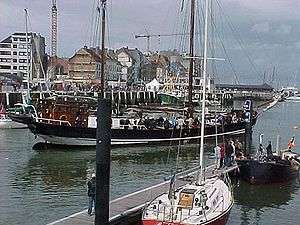Albatros (1899)
 | |
| History | |
|---|---|
| Name: | Albatros |
| Builder: | Kalkman, Capelle aan den IJssel |
| Launched: | 1899 |
| Homeport: | Amsterdam |
| Identification: |
|
| Status: | in service |
| General characteristics | |
| Tonnage: | 119 tonnes gross |
| Displacement: | 170 tonnes |
| Length: | 40 m (131 ft 3 in) |
| Beam: | 6.2 m (20 ft 4 in) |
| Height: | Air draught 28.75 m (94 ft 4 in) |
| Draught: | 1.9 m (6 ft 3 in) |
| Propulsion: | 415 m2 (4,470 sq ft) Sails, 160 hp (120 kW) Hundested 2 cylinder diesel engine |
| Sail plan: | Ketch |
| Speed: | 6 kn (11 km/h) |
| Capacity: | 15 passengers |
| Crew: | 4 crew |
| Notes: | Was the last commercial sailing ship in Europe. |

Albatros is a sailing ketch built in the Netherlands in 1899. Now used as a sail training vessel, she was the last sailing ship carrying commercial cargo in Europe.
History
1899-1987
Albatros was built at Capelle aan den IJssel in the Netherlands in 1899 as a Noordzee Klipper or Galliot. Her first captain was Johannes Muller of Middelharnis, near Rotterdam. In 1920 she was sold to Captain Lolk from Svendborg. In 1941, Lolk sold Albatros to Captain Rasmussen from Hobro. During the Second World War, Albatros was used to smuggle Jews and political dissidents from Nazi-occupied Denmark to neutral Sweden and smuggled weapons for the Danish Resistance hidden amongst her cargo on the return journey. See also Rescue of the Danish Jews. Her rigging was reduced in 1964 and the rivetted steel below the waterline replaced with welded steel,[1] and a more powerful engine fitted to replace the engine that was fitted in 1933. Rasmussen retired in 1978, and Albatros was laid up in Copenhagen. In 1980, Antonius "Ton" Brouwer bought Albatros, and made Amsterdam her new home port. She was restored by Germanischer Lloyd between 1983 and 1987 and recommissioned as a sailing cargo ship.[2]
1988-1996
Her first cargo after restoration was soya beans to Macduff, Scotland. Between 1987 and 1996, she was often to be seen at Wells next the Sea delivering her cargo of soya beans. With the closure of Wells as a commercial port in September 1995 her career as a cargo ship was finally over. The final load of 100 tons of soya beans were delivered on 5 September 1996.[2] During this time, her cargos included corn, phosphates and timber. Apart from the regular run between Ghent and Wells, Albatros visited ports in the Channel Islands, Denmark, England, Estonia, Finland, Germany, Norway, Poland, Scotland and Sweden, sometimes making faster passages than motor driven ships.[3]
Since 1996
Albatros was converted to a passenger ship in 1997-98. Between 1998 and 2000, she was chartered and rebuild by Greenpeace and used as a sailing classroom in an environmental education program that led to more than one case of plagiarism by Greenpeace and "The Albatros Project". In 2001, she returned to Wells, and The Albatros Project was created to support the upkeep of the ship.[2] On 22 August 2004, a passenger on board Albatros died when he fell from the rigging. Albatros was in the Thames Estuary at the time, and an investigation was carried out by the MAIB. Three recommendations were made.[4]
References
- ↑ "Albatros - A Dutch Sailing barge". Norfolk Broads. Archived from the original on 2007-12-30. Retrieved 2008-03-10.
- 1 2 3 "Introduction to the albatros". The Albatros Project. Retrieved 2008-03-10.
- ↑ "The Ship". The Albatros Project. Retrieved 2008-03-10.
- ↑ "Report No 7/2005" (PDF). Marine Accidents Investigation Branch. Retrieved 2008-03-10. (PDF)
External links
- HTML version of MAIB report.
- Scale model of the Albatros.
- The Albatros, at Wells-next-the-Sea